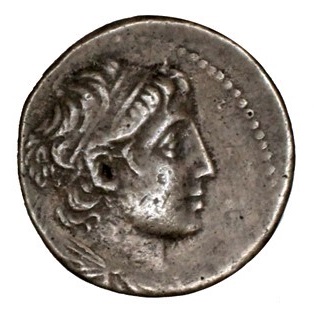Acquisition number: 2009.04
Obv.: Head of Demetrios r., in a circle of dots.
Rev.: ΒΑΣΙΛΕΩΣ ΔΗΜΗΤΡΙΟΥ (‘of King Demetrios’), eagle standing l. on ship’s ram. To l. club surmounted by T monogram (Tyre mint); to r. palm branch over shoulder. Below branch Seleukid era date, characters ΘΞΡ (= 9 60 100) giving ΣΕ 169 = 144/3 BC. Below date characters, monogram.
Title: Tetradrachmon of Demetrios II Nikator - 2009.04
Acquisition number: 2009.04
Author or editor: Hugh Preston
Culture or period: Hellenistic.
Date: 144 - 143 BC.
Material: Metal - Silver
Object type: Coins - Greek
Dimensions: 25mm (w)
Origin region or location: Iraq
Origin city: Seleukeia.
Display case or on loan: 5
Keywords: Coin, Greek, Hellenistic, tetradrachmon, Demetrios II, Syria, Seleukeia, Seleukid
O. Hoover, Handbook of Greek Coinage 13 vols (Classical Numismatic Group, Lancaster, PA, 2009-2013), 9, 970.
A. Houghton, C. Lorber and O. Hoover, Seleucid Coins: A Comprehensive Catalogue, 2 vols (New York, Lancaster and London, American Numismatic Society and Classical Numismatic Group, 2002 and 2008), 1959.
2009.04
Tetradrachmon of Demetrios II Nikator
Silver 14.56 g. 25 mm. 144 - 143 (First reign).
Obv.: Head of Demetrios r., in a circle of dots.
Rev.: ΒΑΣΙΛΕΩΣ ΔΗΜΗΤΡΙΟΥ (‘of King Demetrios’), eagle standing l. on ship’s ram. To l. club surmounted by T monogram (Tyre mint); to r. palm branch over shoulder. Below branch Seleukid era date, characters ΘΞΡ (= 9 60 100) giving ΣΕ 169 = 144/3 BC. Below date characters, monogram.
After the death of Antiochos IV in 164 BC, the Seleukid empire went into decline, with intermittent and short-lived reversals, as encroachment by non-Greek powers was exacerbated by internecine civil war, in which the beginning and the end of a reign was usually marked by the killing of royal kin.
Demetrios II was the elder son of Demetrios I and overthrew Alexandros Balas with the assistance of Ptolemy of Egypt in 145 BC. His precarious rule was mostly confined to the cities of the Phoenician coast. In 139 BC he marched against the Parthians but was captured and remained in honourable captivity at the Arsakid court for the following decade.
When a successor Antiochos VII Sidetes invaded Parthia in 129 BC, Demetrios was released by his captors and managed to seize the kingdom. His second reign lasted till 125 BC.
See also 1985.07.
O. Hoover, Handbook of Greek Coinage 13 vols (Classical Numismatic Group, Lancaster, PA, 2009-2013), 9, 970.
A. Houghton, C. Lorber and O. Hoover, Seleucid Coins: A Comprehensive Catalogue, 2 vols (New York, Lancaster and London, American Numismatic Society and Classical Numismatic Group, 2002 and 2008), 1959.

